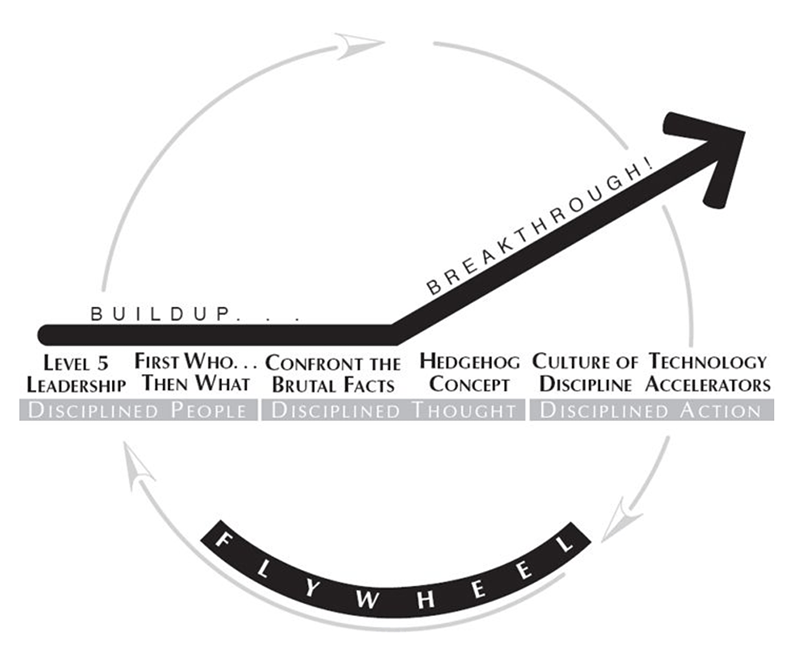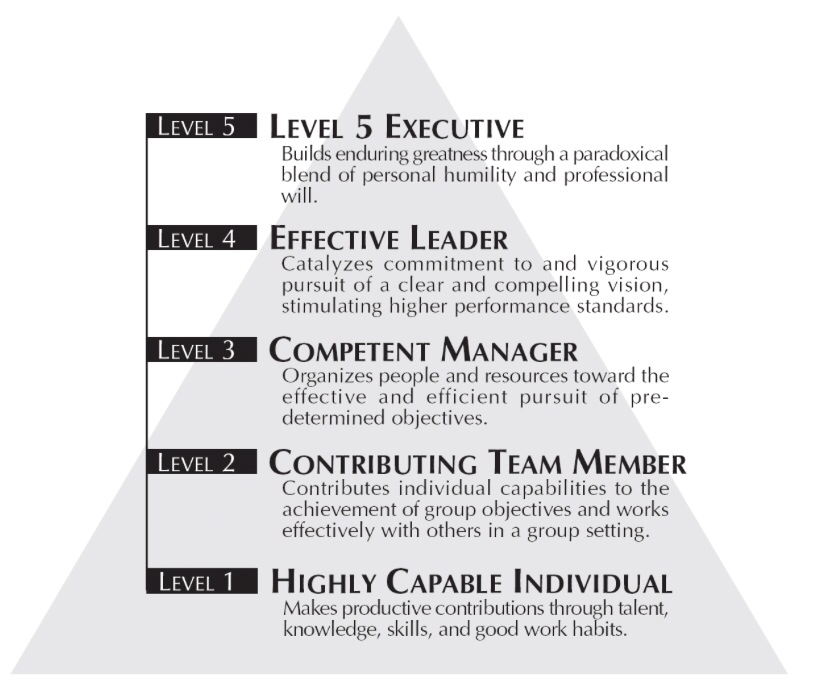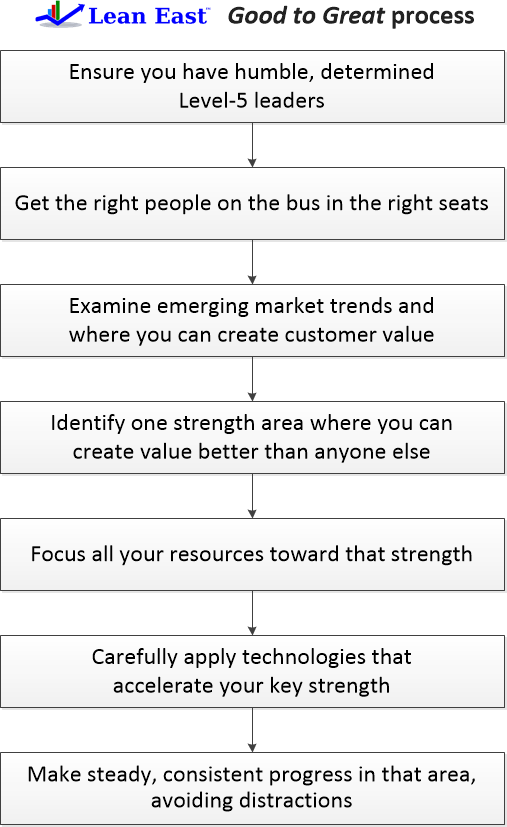Influential management professor Jim Collins released the popular Good to Great: Why Some Companies Make the Leap…and Others Don’t in 2001. The book is really a research project led by Collins as a follow-up to his book Built to Last: Successful Habits of Visionary Companies. He researched hundreds of companies to identify sets of “good” companies where one became “great” while a close competitor failed. Collins and his team tried to discover what the “great” companies did differently from the comparison companies and the general market.
The book is a bestseller that has become a management strategy classic on how to grow a successful company and our team has given the book as a gift to numerous organizational leaders. Key points can be summarized by the image below – this post will summarize the key lessons any top executive can follow.

The Flywheel from Good to Great by Jim Collins
Collins learned that factors such as CEO compensation, technology, mergers and acquisitions, and change management initiatives played relatively minor roles in moving from Good to Great. Instead, Collins found that successes resulted from three main factors:
- disciplined people
- disciplined thought
- disciplined action
The book’s chapters cover each part of the Flywheel image and explain how the Greatcompanies achieved breakthrough results. Lean East has summarized each chapter into a single lesson and converted the lessons into a process that can transform an organization from Goodto Great.
Disciplined People
Level 5 Leadership: Jim Collins found a common characteristic of the great companies was great leadership. Specifically, Collins defined “Level 5 Leadership” as a key to moving from good to great.

Level 5 leaders achieve better results than the “strategic and effective” Level 4 leaders. Level 5 leaders also have intense determination and profound humility. They remain humble learners while having a steadfast resolve. Level 5 leaders establish a set of core values focused on a higher purpose than mere profit generation. Collins found these leaders were committed to the long-term success of their organizations, and many rose to a leadership role from within the company.
“Mix personal humility with professional will”
Get the right people on the bus: People assume that new business leaders immediately begin by announcing where they’re going—by setting a new direction or by articulating a fresh corporate vision. In fact, the leaders of companies that went from good to great started not with “where” but with “who.” Start by getting the right people on the bus, the wrong people off the bus, and the right people in the right seats. Then review the core values and establish a vision.
“First Who, then What?”
Disciplined Thought
Confront the Brutal Facts: Companies transitioning from Good to Great must be willing to identify and assess defining facts in the company and in the larger business environment. Collins outlines a four-step process to promote awareness of emerging trends and potential problems:
1) Lead with questions, not answers.
2) Engage in dialogue and debate, not coercion.
3) Conduct autopsies without blame.
4) Build red flag mechanisms that turn information into information that cannot be ignored.
“Become aware of emerging market trends and potential problems”
The Hedgehog Concept: Simplicity leads to greatness. When confronted by predators, the hedgehog’s instinct is to curl up into a protective ball. This single response is simple and works as a response to any attack. To transition from Good to Great, companies should focus on doing one thing better than anyone else in the world. This single-function will become the organization’s “Hedgehog Concept.”
Collins suggests the following steps to help expedite this process:
- Determine what you can be best in the world at and what you cannot be best in the world at
- Determine what drives your economic engine
- Determine what you are deeply passionate about
“Do one thing better than anyone else”
Disciplined Action
A Culture of Discipline: Sustained great results depend upon an overarching organizational culture of discipline. The single most important discipline is fanatical adherence to the Hedgehog Concept by shunning opportunities that do not meet your singular “better than anyone else” criteria.
Disciplined thought followed by disciplined action is required. Do not assume this requires a tyrant leader who disciplines – this leads to highly dysfunctional organizations. Every team member is rather afforded the degree of personal empowerment and latitude that is necessary to bring the firm’s envisioned objectives into existence.
“Focus all your resources toward that area of strength”
Technology Accelerators: Good to Great organizations think differently about technology. They avoid fads, instead focusing on where technology can be an accelerator of momentum within the firm’s Hedgehog Concept. None of the Good to Great companies Jim Collins studied began their transformations with pioneering technology, yet they all became pioneers in the application of technology once they fit it within their Hedgehog Concept.
Collins characterizes the ideal approach to technology with the following cycle: “Pause — Think — Crawl — Walk — Run.”
“Carefully apply technologies that accelerate your key strength”
The Good to Great Process
The flywheel effect: A Good to Great transformation looks dramatic to customers and the market, but the beginnings may be unnoticed inside the company. The process is akin to pushing a large, heavy flywheel. It takes a lot of effort to get started and build energy, but with persistent pushing in a consistent direction over a long period, the flywheel builds momentum and eventually can’t be stopped – achieving breakthrough results.
Making decisions and taking actions that reinforce and affirm the company’s Hedgehog competencies initiate positive momentum. This results in the accumulation of tangible positive outcomes and serves to energize and earn the loyalty of the staff.
In contrast to the flywheel effect, the doom loop is characterized by reactive decision-making, an overextension into too many diverse areas of concentration, following short-lived trends, frequent changes in leadership and personnel, loss of morale, and disappointing results.
“Steady, consistent progress leads to eventual breakthrough”
The Good to Great process: The seven lessons from the book result in a basic process, as shown below.

From Good to Great
The Lean East team would love to hear from any leaders who have used the ideas in this book to transform their organizations. This process takes time to see true results. We are concerned that many organizations and leaders do not have the patience and discipline to keep pushing, especially at the beginning when results are hard to see.
Check out the other studies by Jim Collins: Built to Last and Great by Choice.
Are you a founder, leader, or employee of a smaller, private company? Check out our 7 Lessons from Small Giants: Companies That Choose To Be Great Instead of Big by Bo Burlingham.
Please subscribe to our newsletter for monthly book summaries and learnings from our team. We will update our blog to share our experiences working with several companies currently on this journey soon.